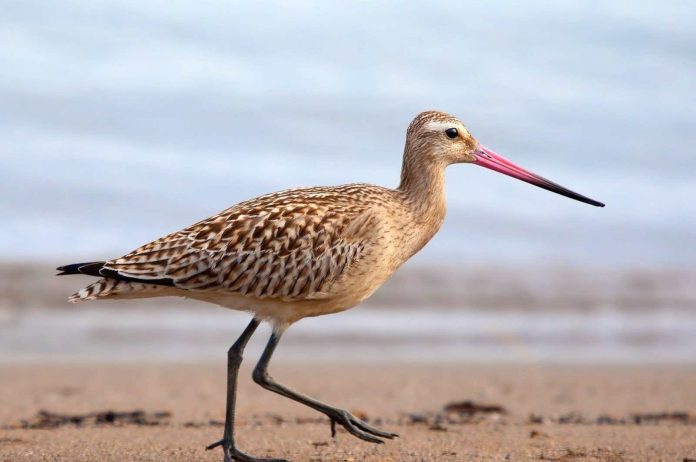A bird has been tracked making a mammoth journey of over 12,000 kilometers (7,500 miles) from Alaska to New Zealand without a single break, setting a new world record for the longest logged continuous flight by a bird.
The bar-tailed godwit, known as 4BBRW, set off from southwestern Alaska on September 16 and touched down in a bay near Auckland, New Zealand just 11 days later, according to Global Flyway Network, a conservation group that studies the migrations of shorebirds.
Data from its satellite tag suggests the bird traveled a distance of 12,854 kilometers (7,987 miles), although the real figure is likely to be closer to 12,200 kilometers (7,580 miles) after accounting for errors, The Guardian reports. Either way, this appears to be a record distance. The previous record was set in 2007 after a bird of the same species completed an 11,680-kilometers (7,258 miles) journey across the Pacific, which outdid all human-made aircraft at the time.
Bar-tailed godwits (Limosa lapponica) are a species of wading bird no stranger to epic migrations. Each year, they breed in the upper reaches of the Northern Hemisphere before venturing on a colossal journey to the Southern Hemisphere for winter. The species can be broken down into at least five subspecies, all of which have their own summer breeding grounds, from North America to Russia and Northern Europe. The largest of the subspecies, L. l. Baueri, breeds in western Alaska but spends its winters in Australia and New Zealand.
During the annual trip, this subspecies is often seen completing journeys of over 10,000 kilometers (6,200 miles). However, this latest record-breaker appears to have gone that little bit further due to strong winds.
“They are flying over open ocean for days and days in the mid-Pacific; there is no land at all. Then they get to New Caledonia and Papua New Guinea where there are quite a few islands and, we might be anthropomorphizing, but it really looks like they start spotting land and sort of think, ‘Oh, I need to start veering or I will miss New Zealand’,” Dr Jesse Conklin, a guest researcher at the Global Flyway Network, told iNews.
The species’ ability to make these long journeys without sleep or food was once a subject of much mystery, but scientists are slowly unpicking how the jet-like birds achieve this feat. A study from 2010 by Lund University in Sweden found that the bar-tailed godwit consumed extremely little energy compared with other species of bird, consuming just 0.41 percent of its body weight each hour during its flight. It also has a near-perfect ratio of body weight to size for completing multi-marathon flights with much of its body weight comprising of fat before it takes on the daunting expedition. On top of this, the bar-tailed godwit is a quick flyer thanks to its exceptionally aerodynamic body shape, which means it can cover long distances in a relatively short space of time.
Nevertheless, questions still remain. For one, scientists have little idea of how the birds navigate these huge distances without getting lost.





























